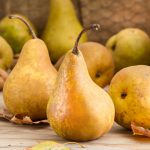There is persuading archeological proof from the unearthing of the antiquated lake tenants in Switzerland that the European pear, Pyrus communis L., was known by that progress. It is accepted that the pear was known by ancient man, however there is no concession to whether the apple started things out or the pear. The antiquated pear tree of Europe was on a very basic level not the same as the Asian pear tree, Prunus pyrifolia.
English records show that in 1629 “stones of pears were sent by the Massachusetts Company to New England” pioneers to plant and develop into trees at Plymouth, MA.
On March 30, 1763 the renowned American, George Mason, made a passage into his broad plantation diary: “joined 10 dark pear of Worchester from Collo… these are an enormous course (coarse) organic product for heating” and old French pear assortment.
Fortress Frederica at Saint Simons Island, Georgia, was set up by the English pilgrims in 1733, simultaneously the city of Savannah was settled. To empower the pilgrims with self continuing food saves, an arrangement was created by General Oglethorpe to present trees and plants for developing both in calm and subtropical atmospheres that would demonstrate significant for future ranches and products of the soil tree plantations in Georgia. These goals were accounted for as per William Bartram in his book, Travels, that was distributed in 1773, after 40 years. John Bartram, the dad and partner in crime of William Bartram, made their examination excursion to East Florida, Carolina, and Georgia somewhat to research assets and plant inventories relinquished by Spaniards to the English as provincial acquisitions.
Ruler nursery was set up as the principal American nursery for the gathering, developing, and selling of plants and trees at Flushing, New York in 1737, Prince nursery promoted “42 pear trees available to be purchased in 1771.”
John Bartram planted the seed of a pear tree in 1793, and this antiquated tree developed and created natural product until the year 1933.
The incomparable American natural hybridizer and author of his epic and amazing 12 volume record of his perceptions on plant advancement over numerous years by Luther Burbank expressed that essentially, there were two hereditary lines of pears that he and others had used to improve the business nature of pear trees and their fruiting. The European pear, Pyrus communis L., the Asian pear, Pyrus pyrifolia, additionally called the Korean pear tree, the Japanese pear tree, the Chinese pear tree, and the Taiwanese pear tree. These were intercrossed to acquire a recombination of qualities to filter out the unpredictable character combinations that would ideally deliver predominant natural product.
Bartram wrote in his ‘Natural product Improvement’ about a pear chance mixture that showed up at a ranch close to Philadelphia, Pennsylvania, a consequence of an European pear and the Chinese sand pear that had been planted on the homestead as fancy nursery trees. This cross breed happened on the ranch of Mr. Peter Kieffer, along these lines bearing his name for the primary hybridized Oriental pear tree. The “Kieffer” pear has a charming fragrance; it is a wonderful and agile tree with gigantic white blossoms, however this pear is best when cooked into jelly or pies in view of its immovability. The cool toughness and sickness obstruction make this pear an important cultivar that stays a top of the line pear tree even today.
Other Oriental pear trees that entered the well known nursery mailorder inventories were Le Conte, Garber, and Smith pear trees. These pear trees became standard cultivars for Gulf State garden plantings, where European pear trees don’t develop well.
Different strains of pears created in California were depicted as tremendous in size, with sensitive tones, scent, and incredible quality. One of these cross breed pears estimated nine inches high and gauged five pounds- – a solitary natural product.
Burbank brought up that the business exchange of pear disapproves of enormous pears as a result of boxing, arranging, and delivery issues, and the normal pear organic product purchaser doesn’t frequently specially purchase oversize pears. The Northwestern United States produce the most business pears, by and large on account of the excellent pastry nature of the organic product. The most established pear market sensation is Bartlett (Williams), that fills in a gathering called “Winter Pears,” including different assortments. Comice, D’Anjou, Bosc, Red D’Anjou, and Concorde pears. These cultivars these cultivars have an extremely limited territory of effective development, as a result of their delicate European pear parentage, Pyrus communis, and are not suggested for filling in most United States areas.
The pear tree is novel as a non-wilting natural product being effectively unmistakable from its ordinary portrayal alluding to the state of the natural product, “pear molded,” a particular structure that everybody gets it. Purchasers of pear organic product are one-sided in buying a pear in the shape they are acclimated with, and they will frequently dismiss the Asian pear, ‘Pyrus pyrifolia, a round or apple formed natural product. The surface of pears is interesting among natural products alongside smell, taste and the possibility that pears (European clones) should be taken out the tree to age later; while, the Asian pears are better left on the trees to mature for full flavor advancement.
The skin of pears fill in a wide cluster of tones, green, yellow, orange, red, and mottled, and this makes an extraordinary defensive shield from the eyes of fowls and different creatures. Pear trees require longer times of development to start fruiting than most other natural product trees, yet the tree will bear prior whenever united on an overshadowing quince rootstock; notwithstanding, most tree traders offer semi-bantam trees available to be purchased, and obviously, bigger trees start fruiting sooner than little trees. Asian pear trees produce organic product sooner than those trees with European pear heritage. One factor that has postponed the spread of pear trees since relic is the way that the seeds show helpless germination achievement except if they are clammy and most voyagers on the old “Silk Road” exchanging courses dried the seed for selling or trading.
Natural product purchasers of America have indicated a sensational and expanded interest in buying new pears at the supermarket in the previous 25 years. The USDA assets express that the per capita utilization of table quality, new pears has expanded more than most organic products, while the purchasing of new peaches has diminished. New pears can be kept at close to frosty temperatures for up to 5 months for shopper purchasing later. For patio landscapers, pear trees can grow 20-30 feet on semi-bantam rootstock and are all around adjusted for developing on most soils, even inadequately depleted soils, specially on a pH scope of 6 to 7. Pear trees will develop and endure temperatures of negative 20 degrees Fahrenheit.
Burbank performed numerous odd crosses with pear trees. He crossed pears with apples and quince; be that as it may, those mixture trees didn’t develop to deliver adequate organic product.
Pear organic products contain cancer prevention agents and no fat, with medical advantages from Vitamin A, Vitamin B1, Vitamin B2, Vitamin C, niacin, and the minerals Calcium, Phosphorus, Iron, and Potassium.
Numerous cultivars of Pears are suggested for planting. Ayers Pear Tree, Baldwin Pear Tree, Columbus Red Pear Tree, Floridahome Pear Tree, Hood Pear Tree, Kieffer Pear Tree, Leconte Pear Tree, Moonglow Pear Tree, Orient Pear Tree, Pineapple Pear Tree, Sand Pear Tree and the Warren Pear Tree. Four assortments of Asian Pears are additionally planted: the Korean Giant Pear Tree, Hosui Pear Tree, Shinseiki Pear Tree, Twentieth Century Pear Tree.










